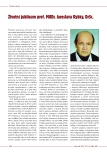An outlook to the future of pharmacotherapy for type 2 diabetes mellitus
Authors:
A. Šmahelová
Authors‘ workplace:
Klinika gerontologická a metabolická Lékařské fakulty UK a FN Hradec Králové, přednosta prof. MUDr. Luboš Sobotka, CSc
Published in:
Vnitř Lék 2011; 57(11): 954-958
Category:
Birthday
Overview
A new class of drugs that affect incretin system has been introduced in clinical practice, and renal glucose reabsorption inhibitors are soon to follow. Clinical practice thus has an access to drugs with mechanisms of action that differ from those of the currently available antidiabetics, and extend our ability to influence the multifaceted metabolic disorder associated with the type 2 diabetes. Non-peptide molecules affecting GLP1 receptor and insulin mimetics are being tested in clinical trials. Research also continues in metabolic modulators of nuclear receptors, glucagon receptor antagonists and cellular glucocorticoid inhibitors. Promising are the compounds that increase glucose utilization (glucokinase activators) and decrease its release (fructose-1,6-diphosphatase inhibitors). Gene therapy is also likely to be used for the treatment of type 2 diabetes and its complications.
Key words:
antidiabetics – insulin mimetics – PPAR modulators – incretin treatment – cyrbohydrate digestive enzyme inhibitors – gene therapy
Sources
1. DeFronzo RA, Ferrannini E, Keen H et al. International Textbook of Diabetes Mellitus. 3th Ed. John Wiley & Sons Ltd. Cholchester, West Sussex, 2004.
2. Adams CP, Branter VV. Estimating the coast of new drug development: is it really 802 million dollars? Health Aff 2006; 25 : 420–428.
3. Bailey CJ. Treating insulin resistance: future prospects. Diab Vasc Dis Res 2007; 4 : 20–31.
4. Chandalia M, Garg A, Lutjohann D et al. Beneficial effects of high dietary fiber intake in patients with type 2 diabetes mellitus. N Engl J Med 2000; 342 : 1392–1398.
5. Haluzík M, Svačina Š. Inkretinová léčba diabetu. Praha: Mladá Fronta 2010.
6. Saltiel AR, Kahn CR. Insulin signaling and the regulation of glucose and lipid metabolism. Nature 2001; 414 : 799–806.
7. Kahn SE, Hull RL, Utzschneider KM. Mechanisms linking obesity to insulin resistence and type 2 diabetes. Nature 2006; 444 : 840–846.
8. Bailey CJ. Treating insulin resistence: future prospects. Diab Vasc Dis Res 2007; 4 : 20–31.
9. Tokunaga C, Yoshino K, Yonezawa K. mTOR integrates amino acid - and energy-sensing pathways. Biochem Biophys Res Commun 2004; 313 : 443–446.
10. Machem VP, Glodfine ID, Kohanski RA et al. A novel small molecule that directly sensitisez the insulin receptor in vitro and in vivo. Diabetes 2001; 50 : 824–830.
11. Šmahelová A. Inzulin senzitizující léky. Vnitř Lék 2009; 55 : 425–428.
12. Gross B, Staels B. PPAR agonists: multimodal drugs for the treatment of type-2 diabetes. Best Pract Res Clin Endocrinol Metab 2007; 21 : 687–710.
13. Tenenbaum A, Motro M, Fisman EZ. Dual and pan-peroxisome proliferator-activated receptors (PPAR) co-agonism: the bezafibrate lessons. Cardiovasc Diabetol 2005; 4 : 14.
14. Tomlinson JW, Stewart PM. Modulation of glucocorticoid action and the treatment of type 2 diabetes. Best Pract Res Clin Endocrinol Metab 2007; 21 : 607–619.
15. Bailey CI. New pharmacological approaches to glycemic control. Diabetes Revs 1999; 7 : 94–113.
16. Schimack G, DeFronzo RA, Musi N. AMP-activated protein kinase: role in metabolism and therapeutic implications. Diabetes Obes Metab 2006; 8 : 591–602.
17. Iglesias MA, Furler SM, Cooney GJ et al. AMP-activated protein kinase activation by AICAR increases both muscle fatty acid and glucose uptake in white muscle of insulin-resistant rats in vivo. Diabetes 2004; 53 : 1649–1654.
18. Milne JC, Lambert PD, Schenk S et al. Small molecule activators of SIRT1 as therapeutics for the therapeutics for the treatment of type 2 diabetes. Nature 2007; 450 : 712–716.
19. Pasarica M, Shin AC, Yu M et al. Human adenovirus 36 induces adiposity, increases insulin sensitivity, and alters hypothalamic monoamines in rats. Obesity (Silver Spring) 2006; 14 : 1905–1911.
20. Rogers PM, Mashtalir N, Rathod MA et al. Metabolically favorable remodeling of human adipose tissue by human adenovirus type 36. Diabetes 2008; 57 : 2321–2331.
21. Wang ZQ, Cefalu WT, Zhang XH et al. Human adenovirus type 36 enhances glucose uptake in diabetic and nondiabetic human skeletal muscle cells independent of insulin signaling. Diabetes 2008; 57 : 1805–1813.
22. Hirsch T, Spielmann M, Velander P et al. Insulin-like growth factor-1 gene therapy and cell transplantation in diabetic wounds. J Gene Med 2008; 10 : 1247–1252.
Labels
Diabetology Endocrinology Internal medicineArticle was published in
Internal Medicine

2011 Issue 11
Most read in this issue
- Antibiotic treatment of acute bacterial infections
- Modern technologies in diabetology. CSII (Continuous Subcutaneous Insulin Infusion) and CGM (Continuous Glucose Monitoring) in clinical practice
- Management of obesity – options, effectiveness and perspectives
- Genetics of monogenic forms of diabetes
